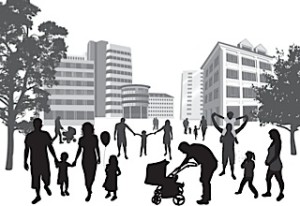
Two out of every five EU citizens live in urban regions, a further one in three inhabits suburban or intermediate regions and fewer than one in four reside in rural regions, according to EU statistics agency Eurostat. The figures are based on new criteria for defining urban and rural regions developed by the European Commission. (http://epp.eurostat.ec.europa.eu/cache/ITY_PUBLIC/1-30032012-BP/EN/1-30032012-BP-EN.PDF)
In the context of the CAP, it is important to keep sight of the fact that both urban and intermediate regions are likely to remain net importers of agricultural products. So while agricultural land accounts for 40% of the EU land surface, fewer than one in four of the EU’s population live in a rural region (1) – and only a small proportion of the total population is directly employed on the land (2).
This generates a number of paradoxes, not least the inherently weak share of political voice for rural areas in deciding agricultural policy. This is a longstanding structural issue, which throws up some unexpected insights when the data is rearranged in simple ways. Follow link for data spreadsheet: Eurostat_March_2012_population_statistics.
France, for instance, might only have 604,000 farmers left out of 6 million postwar peasants, but it still has nearly 30% of its 64 million population in rural areas, of whom a total of 970,000 are employed directly on the land. Small wonder, then, that outgoing president Nicolas Sarkozy should have gone to the hustings promising to cut the cost of getting a driving licence so that young people could find work (“Conduire pour travailler plus…”). Without transport to reach more distant jobs, rural isolation is a problem for all age groups, not just the elderly.
As in so many other post-industrial member states, a demographic time bomb has been ticking for years and is ready to go off. An ageing agricultural workforce is reaching and passing retirement age: within the next CAP cycle this will be a real problem, not just an imminent crisis.

The high levels of capitalisation in industrial agriculture and systemic volatility in the European economy means that many aspiring new entrants cannot step forward and rejuvenate the sector. The time spans over which market forecasts can relied on for business plans are just not long enough for commercial lenders to be able to support young farmers wanting to set up in agriculture. Is it any wonder that agricultural colleges are struggling to find intake?
The French countryside has seen a steady growth in specialist agricultural technicians, peripatetic specialists such as harvester drivers, who are booked to fill seasonal needs. As a way of spreading capital costs between a number of holdings, it is both simple and effective.
But these latterday journeymen still depend on existing farm businesses for a living. They may be capitalised for a piece of specialist machinery, but they are a long way from becoming farmers in their own right.
France’s rural population grew by 5.1% between 2009 and 2010. This may be lower than the urban growth rate of 5.9%, but sufficient to keep rural employment on the political agenda. By contrast, the Irish government is confident that food production will fuel the country’s future economic growth.
Unlike any other EU member state, three quarters of the Irish Republic’s four million inhabitants are rural, indeed the European Commission has not identified any intermediate regions in its NUTS 3 indexing of Eire. It is history, not coincidence, that explains why the republic’s three largest centres of population should be major ports on the eastern seaboard, any more than why the country should be a net food exporter, with an increasingly long reach for its exports.
In contrast, the UK is the third most populous member state, yet just 3% of its population lives in rural areas. As well as concentrating land ownership, it also makes an active interest in agricultural policy something of a rarity among the 97% of British town dwellers.
In the UK, transporting food has had priority over production for the past two hundred years. This once relied on a strong merchant shipping fleet that only ever faced serious reversals during three periods over the past two centuries: the Napoleonic wars, 1915-18 and 1939-1945.
It may have been made to work for England for centuries, but there is no basis for supposing that such fossilised thinking has a future. To be sure, 97% of the British public have a valid reason to take an interest in the future of European agriculture.
The original Eurostat briefing can be downloaded here: http://epp.eurostat.ec.europa.eu/cache/ITY_PUBLIC/1-30032012-BP/EN/1-30032012-BP-EN.PDF
(1) Under this system, Europe is divided into kilometre squares: to count as urban, population density must exceed 300/sq.km as part of a population of at least 5,000 living at this density in contiguous cells (minimum 17 sq km).
(2) Industrialised member states, such as Germany and the UK have roughly one farmer per 100 capita in the total population. Some active farming populations as approximate percentages of the total labour force are: Germany 1.69%; France 2.53%; UK 1.58% and Irish Republic 8.18%. These figures were calculated using additional Eurostat data Basic figures on the EU – Spring 2012, which made it possible to calculate the labour force by subtracting inhabitants under 15 years and over 65. With the Eurostat agricultural labour force data from the pocket book Food: From farm to fork statistics, it was then possible to establish the active farming population as a percentage of the labour force.





